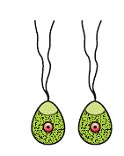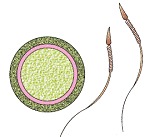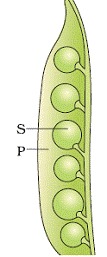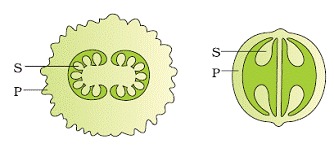Reproduction in Organisms - Revision Notes
CBSE Class 12 Biology
Revision Notes
CHAPTER-01
REPRODUCTION IN ORGANISMS
Reproduction is a biological process of formation of new offsprings from the pre-existing organism.Reproduction becomes a vital process without which species cannot survive for long It ensures continuity of species generation after generations as older individuals undergo senescence and ultimately they die.
Life span - • The period from birth to the natural death of an organism represents its life span. Life span of organisms varies from few days (Butterfly-1to 2 weeks) to thousands of years (Banyan tree).
Types of Reproduction:
Based on whether there is one or two organisms taking part in the process of reproduction
- ASEXUAL REPRODUCTON
- SEXUAL REPRODUCTION
When the offspring is produced by single parents with or without the involvement of gamete formation, the reproduction is called asexual reproduction.
When two parents (opposite sex) participates in reproduction process and also involves the fusion of male and female gametes, it is called sexual reproduction.
Asexual Reproduction
- Usually followed by organisms with relatively simpler organizations.
- Off springs produced by single parent.
- With/without involvement of gamete formation.
- Off springs produced are genetically and morphologically similar to each other and to the parent, i.e. they are clones.
• In Protista and Monera, the parent cells divides into two to give rise to new individuals. Thus, in these organisms cell division is the mode of reproduction itself.
• Binary fission- in this method of asexual reproduction, a cell divides into two halves and rapidly grows into an adult. Ex- amoeba, paramecium.
• Budding- small buds are produced that remain attached initially with parents and get separated on maturation. Ex. Yeast.

• Fungi and simple plants like algae reproduce through special reproductive structures like zoospores (motile structure), conidia (penicillium), buds (hydra) and gemmules (sponges).
• In plants, vegetative reproduction occurs by vegetative propagules like runner, rhizome, sucker, tuber, offset and bulb.

WATER HYACINTH (Terror of Bengal)
- One of the most invasive weeds
- Grows wherever there is standing water
- Drains oxygen from water- leads to death of fishes.
- Introduced in India because of its pretty flowers & shape of leaves
- Vegetative propagation occurs at a phenomenal rate
Asexual reproduction is the most common method of reproduction in organisms having simpler body like in algae and fungi but during unfavorable condition they shift to sexual reproduction.
SEXUAL REPRODUCTION:
- Involves formation of male and female gamete by two individuals of the opposite sex.
- Offspring produced by fusion of male and female gametes not identical to each other or to the parents.
- All sexually reproducing organisms share a similar pattern of reproduction.
• In sexual reproduction, fusion of male and female gametes results in offspring that are not identical to parents.
DIFFERENT PHASES IN SEXUAL REPRODUCTION:
a. Juvenile phase - The period between birth and sexual maturity is called juvenile phase. In plants it is known as vegetative phase.The end of juvenile/vegetative phase marks the beginning of the reproductive phase.
b. Reproductive phase-
• Some plants show flowering in particular season and some other flowers in all seasons. Some other plants like bamboo species flowers once in life time (after 50-100 years), Strobilanthus kunthiana (neelakuranji),flowers once in 12 years.
• The female placental animals exhibit cyclic change in activities ovaries and accessary glands as well as hormone during the reproductive phase.
Menstrual cycle
• It occurs in monkeys, apes and human beings.
• Cycle consists of 3 phases-menstrual, proliferative and secretory phase.
• Blood flows in the last few days of the cycle. The broken endometrium is passed out during menstruation.
• Female does not permit copulation during menstrual phase of the cycle.
Oestrous cycle
• It occurs in non primates like cow, sheep, rat, deer, dog, tiger etc.
• It consists of a short period of oestrous or heat. it is 12-24 hours in cow followed by anoestrous or passive period.
• Blood does not flow in this cycle. The broken endometrium is reabsorbed.
• Female permits copulation only during oestrous period.
• Both in plants and animals, hormones are responsible for the transition between different phases of life cycle. Interaction between hormones and environmental factors regulate the reproductive processes.
c. Senescent phase -
- It is the end of reproductive phase.
- Old age ultimately leads to death
Events in Sexual Reproduction : Pre-fertilisation, Fertilisation, Post-fertilisation
Pre-fertilisation- all the events prior to fusion of gametes are included in it. It includes gametogenesis and gamete transfer.
a. Gametogenesis is the process of formation of male and female gametes. Gametes are haploid cells which may be similar or dissimilar in structure. In algae, both gametes are similar in structure called homogametes (isogametes). In higher organism that reproduces sexually, two morphologically distinct gametes are formed called heterogametes, male gametes are called antherozoid or sperm and female gametes are called ovum or egg.


Isogametes. heterogametes
In fungi and plants, homothallic and monoecious terms are used to denote the bisexual condition and heterothallic and dioecious are used for unisexual condition. In flowering plants, the unisexual male flower is staminate, i.e., bearing stamens, while the female is pistillate or bearing pistils.
• In animals, species which possess both male and female reproductive organs in same individual are called bisexual or hermaphrodites (earthworm, sponges, tapeworm etc.) and both having either male or female reproductive organs are called unisexual (cockroach, human).
• Gametes are always haploid( having half set of chromosome ), although organisms may be haploid and diploid. Diploid organisms form gametes by meiotic division. The organisms belonging to algae, fungi, and bryophytes have haploid plant body and pteridophytes, gymnosperms, angiosperms and most of animals are diploid ( having double set of chromosome )
• In diploid organisms, gamete mother cell (meiocyte) undergoes meiosis in which one set of chromosome is present in gametes.
b. Gamete Transfer – in majority of organisms, male gametes are motile and females gametes are non-motile, except in fungi and algae in which both gametes are motile.
• In simple plants like algae, fungi, bryophytes and pteridophytes water is the medium through which male and female gametes moves. The number of male gametes are much more than number of female gametes as most of male gametes fail to reach the female gametes.
• In higher plants pollen grains are carrier of male gametes and ovule has eggs. Pollen grains must be transferred from anther to stigma to facilitate fertilisation. The transfer of pollen grains from anther to stigma is called pollination. Pollination may be self (anther to stigma of same flower) or cross (anther to stigma of different flower).
• Pollen grains germinate on stigma to produce pollen tube that delivers the male gametes near the ovule.
c. Fertilisation – The fusion of male and female gamete is called fertilization or syngamy. It results in the formation of diploid zygote.
• The process of development of new organisms without fertilisation of female gametes is called parthenogenesis. For example honey bee, rotifers, and lizards
EXTERNAL FERTILIZATION | INTERNAL FERTILIZATION |
Syngamy occurs outside the body of the organism Large numbers of gametes are released in the surrounding medium. | Syngamy occurs inside the body of the organism Numbers of ova produced are less, but large numbers of male gametes are released and they travel towards the ovum. |
d. Post Fertilisation Events- events in the sexual reproduction after formation of zygote.
Zygote is the vital link that ensures continuity of species between organisms of one generation and the next. Every sexually reproducing organism, including human beings begin life as a single cell–the zygote.
• In the organisms, having external fertilisation, zygote is formed in external medium (water) and those having internal fertilisation zygote is formed inside the body of female.
• In algae and fungi, zygote develops a thick wall resistant to desiccation and damage. This germinates after a period of rest.
• In the organisms having haplontic life cycle, zygote divides to form haploid spores that germinate to form haploid individual.
Embryogenesis – the process of development of embryo from the zygote. During this, zygote undergoes mitotic division and cell differentiation. Cell division increase the number and cell differentiation help in formation of new group of cells and organs.
Oviparous | Viviparous |
Development of zygote takes place outside the body of organisms and lay fertilized of unfertilized eggs. Ex - Reptiles and birds. | Development of zygote takes place inside the body of organisms and produces young ones. Ex- Human, dog, horse etc. |
• In flowering plants, zygote is formed inside the ovule. After fertilisation, sepals, petals and stamens of flower fall off. The zygote develops into embryo and ovules into seeds. The ovary develops into fruits which develop a thick wall called pericarp, protective in function.
• After dispersal, seeds germinate under favorable condition to produce new plants.


A few kinds of fruit showing seeds (S) and protective pericarp (P)